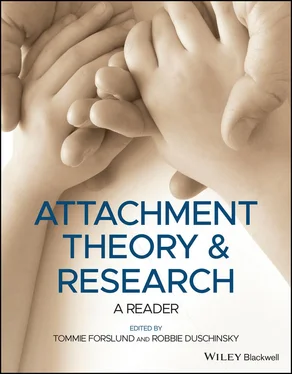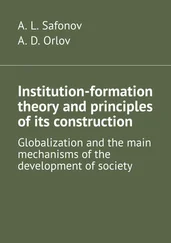1 Cover
2 Title Page Attachment Theory and Research A Reader Edited by Tommie Forslund and Robbie Duschinsky
3 Copyright Page
4 Introduction Suggested Further Reading References
5 1 Separation Anxiety Observations of Young Children Principal Theories Primary Anxiety, Fright, and Anxiety Dependent on Learning Ingredients of Separation Anxiety Origin of Separation Anxiety of Pathological Degree Conclusion Appendix: Appendix References
6 2 Anxiety, Stress, and Homeostasis Homeostasis Homeorhesis Health and Ill‐Health Disturbances of Homeostasis Threats of Disturbance of Homeostasis A Distinction Between Fear (or Alarm) and Anxiety 15 Inter‐relations of Fear (or Alarm) and Anxiety Fear and Anxiety, Conscious and Unconscious
7 3 Attachment Deprivation and Separation Bowlby’s Theory of Infant–Mother Attachment The Caregiving Behavioral System Patterns of Attachment of Infant to Parent The Development of Child–Mother Attachment Beyond Infancy Stability and Change of Patterns of Infant–Mother Attachment Attachment Patterns and Later Development Anxious Attachment and Some Disorders Associated With It Secure Attachment and the Growth of Self‐Reliance Pathways for the Growth of Personality Responses to Loss Childhood Experiences and Cognitive Biases Relevant to Disordered Mourning Affectional Bonds Throughout the Life Span References
8 4 Love as Attachment Attachment Theory Summarized Similarities Between Infant Care‐Giver Attachment and Adult Romantic Love Three Kinds or Styles of Attachment Two Studies of Love as Attachment Limitations of Our Initial Studies Three Behavioral Systems: Attachment, Care Giving, and Sexuality Broken Attachments: Grieving for Lost Love Conclusion References
9 5 Relationships, Self, and Individual Adaptation An Organizational Perspective The Emergence of the Self Self as Inner Organization Empirical Implications of the Organizational/Relationship Perspective Conclusion References
10 6 Disorganized/Disoriented Infant Behavior in the Strange Situation, Lapses in the Monitoring of Reasoning and Discourse during the Parent’s Adult Attachment Interview, and Dissociative States Attachment Theory and Infant Response to Separations from the Parent in a Strange Environment From “Unclassifiable” to “Disorganized/disoriented” Infant Attachment Status: The Recognition of a New Infant Attachment Category and its Probable Relation to Frightening and/or Frightened Parental Behavior Parallel Distributed Processing and Working Memory Summary References
11 7 The Prototype Hypothesis and the Origins of Attachment Working Models: Adult Relationships with Method Results Discussion Concluding Comments References
12 8 Dynamics of Romantic Love A Reference Case: The Feynmans’ Attachment Relationship Still, What About the Feeling of “Love”? What Does it Mean to Say “I Love You”? Putting the Three Behavioral Systems Together Further Questions References
13 9 Integrating Temperament and Attachment The Nature and Nurture of Attachment and Temperament Three Traditional Views on Temperament and Attachment: Orthogonal, Oblique, and Reciprocal Reconciliation and Integration: Diathesis–Stress and Differential Susceptibility The Moderating Role of Temperament Directions for Future Research Further Reading References
14 10 Annual Research Review Introduction Clinical Presentation: Classification and Measurement Causes and Risk Correlates of RAD and DSED Course and Outcomes Effects of Intervention Future Directions References
15 11 Attachment Disorders Versus More Common Problems in Looked After and Adopted Children Introduction Method Results Discussion References
16 12 Attachment in the Early Life Course The Developmental Significance of Early Attachment Security The Developmental Significance of Early Avoidant, Resistant, and Disorganized Attachments Looking Ahead and Conclusion References
17 13 Attachment and Biobehavioral Catch‐up Introduction Summary References
18 14 Children’s Multiple Attachment Relationships and Attachment Representations Conclusions References
19 15 New Correlates of Disorganization from a West‐African Dataset, and Background Theoretical and Empirical Background Methods Results Discussion Conclusions References
20 Index
21 End User License Agreement
1 Chapter 4Table 4.1 Comparison of the features of attachment and adult romantic loveTable 4.2 Adult attachment types and their frequenciesTable 4.3 Attachment style and the experience of loveTable 4.4 Attachment style and mental modelsTable 4.5 Previous conceptions of love componentscompared with attachment the...
2 Chapter 5Table 5.1 Stages of the emerging selfTable 5.2 Observations of pairs of preschool children with anxious (A) or res...
3 Chapter 7Table 7.1 Concordance of current relationship interview (CRI) and adult attac...Table 7.2 Pearson correlations between analogous adult attachment interview (...Table 7.3 Concordance between subjects’ security classifications on the curre...
4 Chapter 11Table 11.1 Percentage of psychiatric disorders in ONS data; diagnoses and sym...
5 Chapter 15Table 15.1 Descriptive statistics for dysfluent communication, maternal conta...Table 15.2 Distribution of non‐West SSP classifications and correlating measu...
1 Chapter 4Figure 4.1 The dynamics of infant–mother attachment and adult romantic love....
2 Chapter 9Figure 9.1 Various causal pathways between temperament, attachment, and pare...Figure 9.2 Steps in testing for differential susceptibility.Figure 9.3 Graphical display of differential susceptibility in comparison wi...
3 Chapter 12Figure 12.1 Combined effect sizes for the four attachment categories for soc...Figure 12.2 Combined effect sizes for secure versus insecure infants and chi...
4 Chapter 13Figure 13.1 Conceptual model for anticipated effects of ABC on key outcomes ...
5 Chapter 15Figure 15.1 Setting for weigh‐in procedure.Figure 15.2 Four‐Way Distributions of SSP‐Classifications in the Dogon sampl...
1 Cover
2 Table of Contents
3 Begin Reading
1 iii
2 iv
3 1
4 2
5 3
6 4
7 5
8 6
9 7
10 8
11 9
12 10
13 11
14 12
15 13
16 14
17 15
18 16
19 17
20 18
21 19
22 20
23 21
24 22
25 23
26 24
27 25
28 26
29 27
30 28
31 29
32 30
33 31
34 32
35 33
36 34
37 35
38 36
39 37
40 38
41 39
42 40
43 41
44 42
45 43
46 44
47 45
48 46
49 47
50 48
51 49
52 50
53 51
54 52
55 53
56 54
57 55
58 56
59 57
60 58
61 59
62 60
63 61
64 62
65 63
66 64
67 65
68 66
69 67
70 68
71 69
72 70
73 71
74 72
75 73
76 74
77 75
78 76
79 77
80 78
81 79
82 80
83 81
84 82
85 83
86 84
87 85
88 86
89 87
90 88
91 89
92 90
93 91
94 92
95 93
96 94
97 95
98 96
99 97
100 98
101 99
102 100
103 101
104 102
105 103
106 104
107 105
108 106
109 107
110 108
111 109
112 110
113 111
114 112
115 113
116 114
117 115
118 116
119 117
120 118
121 119
122 120
123 121
Читать дальше












